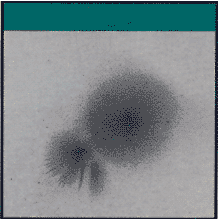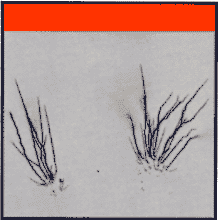Storing, Handling and Processing Electron Micrographs
Some of the challenges confronting an electron microscopist are specimen preparation, microscopic evaluation and photographic technique. However, it is that final photographic image of the specimen which allows you to evaluate and communicate your findings. You can achieve the quality, consistency, and repeatability you require in your electron micrographs by following a few basic guidelines for storing, handling, and processing Electron Micrography Products:
Storing Electron Micrography Films
Electron Micrography (EM) films are photographic products and because of their special properties they can change with time. These changes may be accelerated by high temperatures, high relative humidity, and chemical interaction with materials that are not photographically inert (such as certain plastics, solvents, lacquers, paints, and gases).
Storing films for an extremely long time or under adverse conditions could produce a loss of speed, an increase in fog, a change in contrast, or a combination of all of these effects. You can prolong the life of your EM films by adhering to the following simple rules.
Unexposed Films
As a general rule, avoid high temperatures and high humidity. Electron Micrography Films can be stored at room temperature if it doesn't exceed 70F (21C) in their original moisture-proof packaging at a 50% relative humidity.
Warm-up Time After Removal From Cold Storage
To avoid condensation of moisture on cold film surfaces, let films warm up to approximate room temperature before opening vapor-tight packaging in use. Warm-up times are based on separating cartons from one another after removal from cold storage for better air circulation. Warm-up time is 2 hours from refrigerator or 3 hours from freezer.
Exposed Films
Process films as soon as possible after exposure to avoid deterioration of the latent image. You can store exposed EM films for about 72 hours if the temperature is below 75F (24C) and the relative humidity is 50% or lower. If you must store films for a longer time, protect them from moisture by enclosing them in an airtight can or jar and placing them in a refrigerator. Do not leave exposed films in the platens any longer than necessary.
Processed Films
For long-term keeping of EM films, particular attention must be paid to processing procedures. Refer to the section on "Processing for Image Stability" in this publication and follow processing instructions very closely. EM negatives and prints can be stored at normal temperatures-about 70F (21C) or lower. They should be kept in a dry place where the relative humidity is between 30 and 50%; a relative humidity below 30% causes excessive brittleness while above 60% encourages mold and fungus growth. It is best to keep temperature and humidity constant.If the temperature is moderately higher temporarily, this should cause no harm if the relative humidity is less than 40%. Temperatures above 75F (24C) combined with relative humidity above 60% cause accelerated growth of mold or fungus, deterioration of the image, and sticking together or glazing of the negative surfaces.
Protect your negatives and prints from fumes of certain sulfur compounds (such as hydrogen sulfide and coal gas) and from fumes of nitrogen oxides, peroxides, formaldehyde, ozone, and other harmful oxidizing gases. While latex paints pose no problems, fumes from oil-base paints can cause serious discoloration; do not return negatives to an area freshly painted with oil-base paints for at least 4 weeks.
Darkroom Handling and Using Safelights
Because the emulsion and base sides of films can be easily scratched by rough handling, and surfaces marked by contact with moist fingers, several precautions should be observed when handling EM photographic products in the darkroom. The following guidelines for darkroom handling will help you avoid the most common pitfalls.
- Check your film-loading and processing room for light leaks. To do this, turn off all the lights and remain in the darkened room for about 10 minutes. During this time, your eyes will adjust to the darkness and you will then be able to see if any light is entering the room through cracks around the door, from ventilation or heating ducts, or from other areas.
- Before you turn off the lights to load or process film, make sure that everything you need is within easy reach. If you store exposed films in their original boxes, be sure to label them clearly. Keep boxes of exposed negatives away from boxes of unexposed film to avoid exposing the same material twice.
- Use only the recommended safelight conditions as found in the instruction sheet packed with the films. For more information, see the using safelights section below.
- Handle films by the edges to prevent scratches or abrasions.
- Make certain your hands are clean and completely dry when handling films.
- Remove any particles of dust, paper fibers, or plastic that may have settled on the film during shipment. These particles, if not removed before exposure, can cause unwanted dust spots (pinholes) on the negative and contaminate the microscope column. To remove these particles, brush the emulsion surface with a clean, dry camel's hair brush. A jet of air, nitrogen, or pressurized gas can also be used to blow particles from the surface. If using pressurized gas, be sure that it is clean, oil-free, and dry, and that the air pressure does not exceed 20 psi as excessive pressure can damage the emulsion surface.
- Remove the film from the packaging and load them into the proper holder before prepumping. Do not prepump the film in the opened package containing the protective cardboard as prepumping time will be unduly extended and moisture from these cardboard sheets will quickly contaminate the oil in the mechanical pump.
- Avoid critical exposure at the very edges of the film. The outer 1/4-inch edges may be affected by handling or processing.
Using Safelights
Electron Micrography films should be handled and processed under appropriate safelight conditions. Carestream Molecular Imaging recommends a safelight lamp equipped with a Safelight Filter GBX-2 and 15 W frosted bulb for maximum protection and greatest darkroom visibility. A safelight should be positioned such that it will always be 4 feet (1.2 meters) or more from the film.
Avoiding Static Marks
When films are subjected to friction, they may become positively or negatively charged with static electricity, especially when the relative humidity is low. The film then tries to return to a neutral state by transferring electrons to or from other objects. Sometimes this transfer occurs slowly without any adverse effects, but sometimes the charge builds up faster than it can safely dissipate. At those times, a sudden discharge produces heat, light, and ultraviolet radiation. The ultraviolet radiation forms a latent image on the film in the shape of the static discharge, producing unwanted images on your processed negatives.
The branch-like markings you see occasionally on negatives are caused by such static discharge. They are characteristic of a negative charge that is discharged to a small point or object. Static markings can, however, take a number of other forms that are not so easily recognized. For example, diffuse spots with dark centers are produced when a charge builds up on the film platen and then discharges to the film.
During manufacturing and packaging, Carestream takes every possible precaution to avoid the buildup of static charges on sensitized products. The following precautions will help you avoid problems caused by static:
- Avoid handling film with sudden movements that might cause friction.
- If possible, keep the relative humidity at 40 to 60% in the areas where you load and unload film.
- Move platen parts slowly, and withdraw components slowly when loading or unloading film.
|
|
| Circular spots with dark centers are caused by a discharge from a nearby object to positively charged film. | Branch-like static marks are caused by a discharge from a small negatively charged point or object. |





